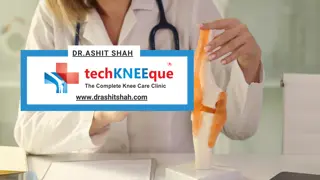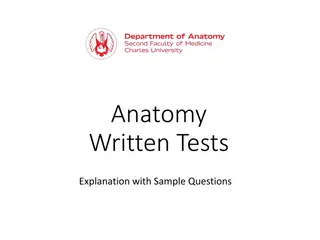Understanding Knee Anatomy and Injuries
Explore the intricate structures of the knee joint, including the femur, patella, meniscus, ligaments, and muscles. Learn about common knee injuries and their impact on stability and function. Delve into the complexities of the ACL, PCL, MCL, and LCL ligaments, crucial for knee integrity during various movements. Gain insight into the role of muscles like the rectus femoris in knee extension and potential injury risks associated with them.
Download Presentation

Please find below an Image/Link to download the presentation.
The content on the website is provided AS IS for your information and personal use only. It may not be sold, licensed, or shared on other websites without obtaining consent from the author. Download presentation by click this link. If you encounter any issues during the download, it is possible that the publisher has removed the file from their server.
E N D
Presentation Transcript
THE KNEE ANATOMY AND INJURIES
KNEE ANATOMY Introduction On the diagram, identify and label the structures of the knee.
KNEE ANATOMY On the diagram, identify and label the structures of the knee.
KNEE ANATOMY On the diagram, identify and label the structures of the knee.
KNEE ANATOMY Femur Strongest bone in your body! It bears your weight on rounded CONDYLES that articulate with the tibia. It requires a lot of force to break the femur. Patella A sesamoid bone that sits INSIDE the quadriceps tendon. Its job is to provide extra leverage for the strong quads to contract & move the knee without damaging the tendon due to friction. Meniscus *The meniscus has poor blood supply to the inner 2/3s of the cartilage! Lateral Meniscus An O-shaped piece of cartilage that sits on the lateral side of the tibial plateau. It cushions the knee joint during flexion & extension but is prone to injury due to compression & rotation, a lot of times happening at the same time as an MCL injury. Medial Meniscus A C-shaped & slightly thicker cartilage that pads the medial portion of the tibial plateau. Commonly injured during LCL sprains due to compression, or ACL injuries due to the rotation
KNEE ANATOMY Ligaments Medial Collateral Ligament Provides rotary (twisty ) stability to the medial side of the joint, connected to the tibia & femur. This ligament is very strong & thick, but is still more commonly injured than the LCL due to the mechanism. Lateral Collateral Ligament A cord-like ligament connecting the fibula, tibia, & femur on the lateral side of the joint, also providing rotary stability to the knee. It can be palpated by putting one ankle on the opposite knee while sitting, then finding the joint space between the tibia & fibula on the bent knee. Anterior Cruciate Ligament Cruciate literally translates to cross-shaped in Latin. The ACL begins at the posterior base of the femur & attaches at the anterior top of the tibia. It s fibers control any anterior or forward movement of the knee during movements such as squatting, running, walking up or down stairs, & just walking on a flat surface. Posterior Cruciate Ligament CROSSING from the anterior base of the femur, behind the ACL & attaching onto the posterior top of the tibia, the PCL is in charge on preventing any backward slippage of the tibia during knee movement.
KNEE MUSCLE ANATOMY Anterior Muscles of the Knee
RECTUS FEMORIS MUSCLE Most anterior & superficial quad muscle Main extender of the knee Turns into the quadriceps tendon & holds what bone?! Think of some injuries that may involve this muscle
QUADRICEPS Rectus Femoris Origin Anterior inferior iliac spine (AIIS) Insertion Tibial tuberosity Action Extension of the knee Hip flexion
VASTUS MEDIALIS MUSCLE Most medial quad muscle In charge of internal rotation of the tibia & assists with extension of the knee Also stabilizes the patella medially What are some affects that a weak VMO may have?
QUADRICEPS Vastus Medialis Origin Femur Insertion Tibial tuberosity Action Extension of the knee
VASTUS LATERALIS MUSCLE Most lateral quad muscle Assists with extension of the knee & lateral stabilization of the patella What might over tightness or weakness of this muscle cause?
QUADRICEPS Vastus Lateralis Origin Femur Insertion Tibial tuberosity Action Extension of the knee
VASTUS INTERMEDIUS MUSCLE Most inferior quad muscle sits beneath the rectus femoris Helps extend the knee Makes up the inferior fibers of the quadriceps tendon
QUADRICEPS Vastus Intermedius Origin Anterior femur Insertion Tibial tuberosity Action Extension of the knee
KNEE MUSCLE ANATOMY Posterior Muscles of the Knee
BICEPS FEMORIS MUSCLE Largest muscle in the hamstring group Gives the hamstring its characteristic bulge Divided into how many muscle bellies? How many daily activities can you think of that involve your hamstrings?
HAMSTRINGS Biceps Femoris Origin Long head-ischial tuberosity Short head-posterior femur Insertion Head of fibula Action Extension of hip Flexion of the knee
SEMIMEMBRANOSUS MUSCLE Most medial hamstring muscle Flexes the knee, extends the hip with a straight leg, rotates the tibia medially with a straight leg Palpate the semimembranosus muscle on a partner
HAMSTRINGS Semimembranosus Origin Ischial tuberosity Insertion Posterior medial tibia Action Extension of hip Flexion of the knee
SEMITENDINOSUS MUSCLE Sits right beneath the semimembranosus Medial & inferior Guess what motions this muscle helps with!
HAMSTRINGS Semitendinosus Origin Ischial tuberosity Insertion Anterior tibia Action Extension of hip Flexion of the knee
KNEE VALGUS INJURIES
KNEE VALGUS INJURIES - MCL
KNEE VARUS INJURIES - LCL
KNEE ROTARY INJURIES
KNEE ROTARY INJURIES ACL
KNEE ROTARY INJURIES
THE KNEE HYPEREXTENSION INJURIES
THE KNEE HYPEREXTENSION INJURIES
THE KNEE MENISCUS INJURIES
THE KNEE MENISCUS INJURIES
THE KNEE PATELLA- FEMORAL INJURIES
THE KNEE PATELLA-FEMORAL TRACKING INJURIES
KNEE PATELLA-FEMORAL TRACKING INJURIES
SOAP NOTE WRITE-UP With a partner, place the following information in the correct section of a SOAP Note: A 15 year old female soccer player was running after a ball during a game when she took a step to turn, heard & felt a pop in her left knee, then fell to the ground. She had pain that was a 7/10 at the time but after a few minutes it calmed down. She limped off the field to the evaluation table, barely willing to put weight on her left leg. She still felt a painful pop in the knee with every step. There is already some mild swelling at the lateral aspect of her knee joint. No ecchymosis or deformity. She s never had a knee injury before, just a few jammed fingers but she has a high pain tolerance. Extremely tender to palpation at the lateral joint line; relatively painless everywhere else. Very limited AROM with left knee flexion; 8/10 pain while extending; Unable to perform PROM/MMT. (+) Valgus stress due to compression of lateral knee; (+) Apley s Compression for severe, diffuse pain in the left knee; (+) Apley s distraction for relief of pain; (+) McMurray s for lateral joint line pain, worst during valgus stress & passive knee flexion; (+) Thessaly due to inability to balance in a slight squat on the left leg; (-) Anterior/posterior drawer; (-) Lachman s; (-) Godfrey 90-90























